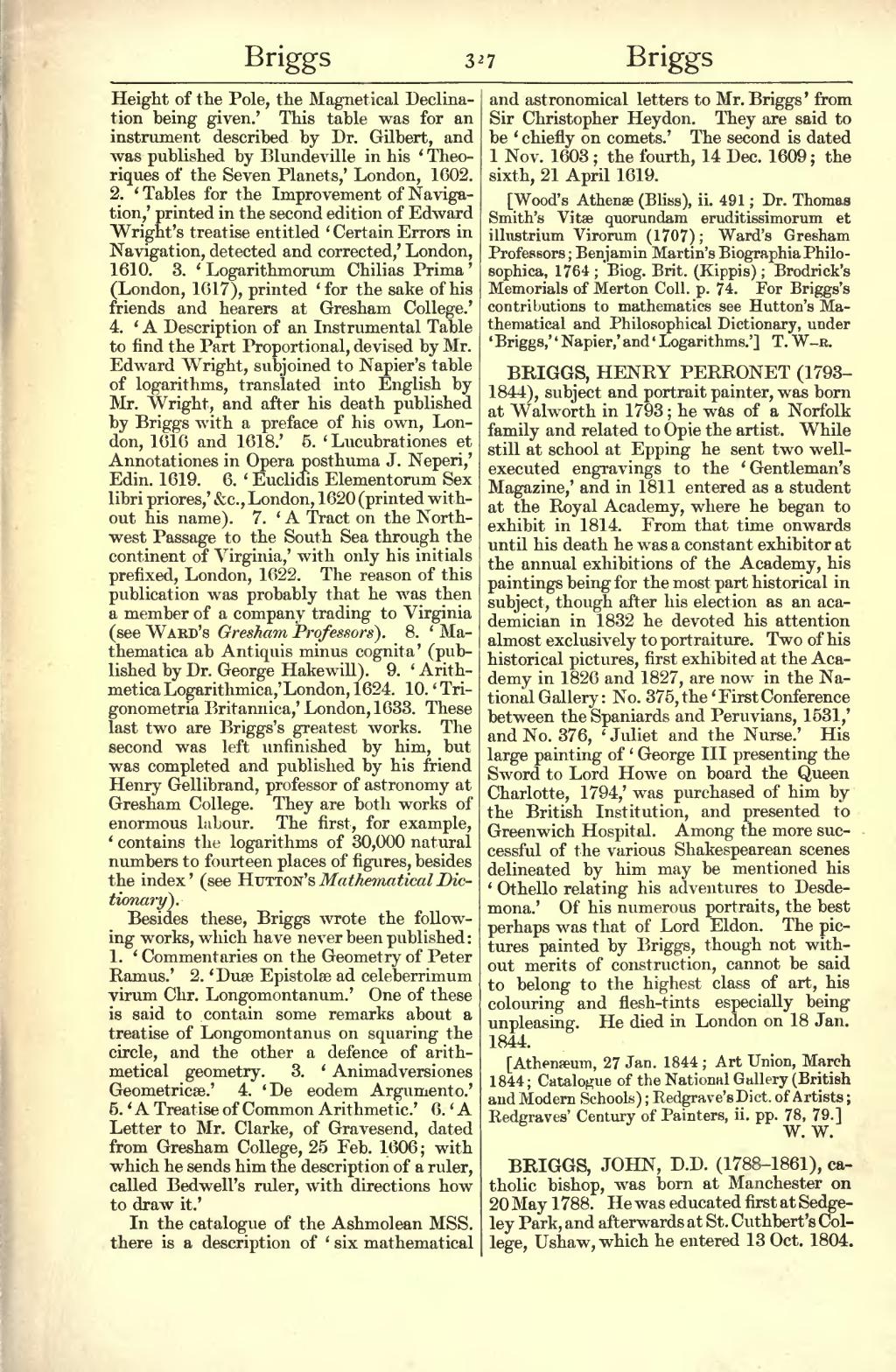- 'Tables for the Improvement of Navigation,' printed in the second edition of Edward Wright's treatise entitled 'Certain Errors in Navigation, detected and corrected,' London, 1610.
- 'Logarithmorum Chilias Prima' (London, 1617), printed 'for the sake of his friends and hearers at Gresham College.'
- 'A Description of an Instrumental Table to find the Part Proportional, devised by Mr. Edward Wright, subjoined to Napier's table of logarithms, translated into English by Mr. Wright, and after his death published by Briggs with a preface of his own, London, 1616 and 1618.'
- 'Lucubrationes et Annotationes in Opera posthuma J. Neperi,' Edin. 1619.
- 'Euclidis Elementorum Sex libri priores,' £c., London, 1620 (printed without his name).
- 'A Tract on the North-west Passage to the South Sea through the continent of Virginia,' with only his initials prefixed, London, 1622. The reason of this publication was probably that he was then a member of a company trading to Virginia (see Ward's Graham Professors).
- 'Mathematica ab Antiquis minus cognita' (published by Dr. George Hakewill).
- 'Arithmetica Logarithmica,' London, 1624.
- 'Trigonometica Britannica,' London, 1633.
Height of the Pole, the Magnetical Declination being given.' This table was for an instrument described by Dr. Gilbert, and was published by Blundeviile in his 'Theoriques of the Seven Planets,' London, 1602.
These two are Briggs's greatest works. The second was left unfinished by him, but was completed and published by his friend Henry Gellibrand, professor of astronomy at Gresham College. They are both works of enormous labour. The first, for example, 'contains the logarithms of 30,000 natural numbers to fourteen places of figures, besides the index' (see Hutton's Mathematical Dictionary).
Besides these, Briggs wrote the following works, which have never been published:
- 'Commentaries on the Geometry of Peter Ramus.'
- 'Duæ Epistolæ ad celeberrimum virum Chr. Longomontanum.'
One of these is said to contain some remarks about a treatise of Longomontanus on squaring the circle, and the other a defence of arithmetical geometry. - 'Animadversiones Geometricæ.'
- 'De eodem Argumento.'
- 'A Treatise of Common Arithmetic'
- 'A Letter to Mr. Clarke, of Gravesend, dated from Gresham College, 25 Feb. 1606; with which he sends him the description of a ruler, called Bedwell's ruler, with directions how to draw it.'
In the catalogue of the Ashmolean MSS. time is a description of 'six mathematical and astronomical letters to Mr. Briggs' from Sir Christopher Heydon. They are said to be 'chiefly on comets.' The second is dated 1 Nov. 1603; the fourth, 14 Dec. 1609; the sixth, 21 April 1619.
[Wood's Athenæ (Bliss), ii. 491; Dr. Thomas Smith's Vitæ quorundam eruditissimorum et illustrium Virorum (1707); Ward's Gresham Professors; Benjamin Martin's Biographia Philosophica, 1764; Biog. Brit. (Kippis); Brodrick's Memorials of Merton Coll. p. 74. For Briggs's contributions to mathematics see Hutton's Mathematical and Philosophical Dictionary, under 'Briggs,' 'Napier,' and 'Logarithms.']
BRIGGS, HENRY PERRONET (1793–1844), subject and portrait painter, was born at Walworth in 1793; he was of a Norfolk family and related to Opie the artist. While still at school at Epping he sent two well-executed engravings to the 'Gentleman's Magazine,' and in 1811 entered as a student at the Royal Academy, where he began to exhibit in 1814. From that time onwards until his death he was a constant exhibitor at the annual exhibitions of the Academy, his paintings being for the most part historical in subject, though after his election as an academician in 1832 he devoted his attention almost exclusively to portraiture. Two of his historical pictures, first exhibited at the Academy in 1826 and 1827, are now in the National Gallery: No. 375, the 'First Conference between the Spaniards and Peruvians, 1531,' and No. 376, 'Juliet and the Nurse.' His large painting of 'George III presenting the Sword to Lord Howe on board the Queen Charlotte, 1794,' was purchased of him by the British Institution, and presented to Greenwich Hospital. Among the more successful of the various Shakespearean scenes delineated by him may be mentioned his 'Othello relating his adventures to Desdemona.' Of his numerous portraits, the best perhaps was that of Lord Eldon. The pictures painted by Briggs, though not without merits of construction, cannot be said to belong to the highest class of art, his colouring and flesh-tints especially being unpleasing. He died in London on 18 Jan. 1844.
[Athenæum, 27 Jan. 1844; Art Union, March 1844; Catalogue of the National Gallery (British and Modern Schools); Redgrave's Dict. of Artists; Redgraves' Century of Painters, ii. pp. 78, 79.]
BRIGGS, JOHN, D.D. (1788–1861), catholic bishop, was born at Manchester on 20 May 1788. He was educated first at Sedgeley Park, and afterwards at St. Cuthbert's College, Ushaw, which he entered 13 Oct. 1804.
